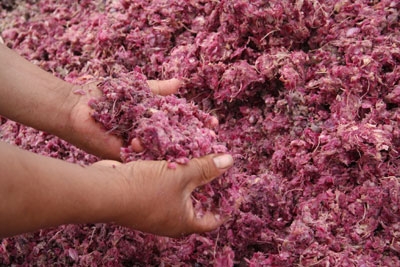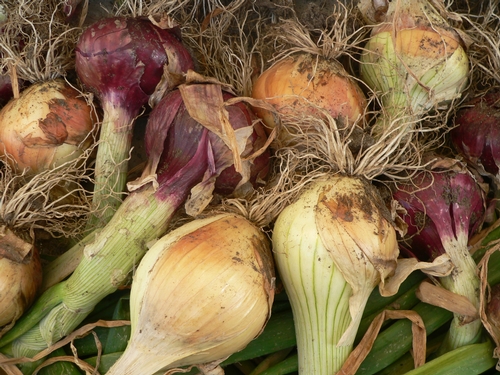Posts Tagged: onions
Lack of pollination due to insecticide use affects onion seed yields, study finds
A lack of pollination by honey bees — brought on by increased insecticide use to control onion thrips — was linked to a sharp decrease in yields of California onion seeds, according to research published in the July-September 2011 issue of the University of California’s California Agriculture journal.
“Honey bee visits to onion flowers were negatively correlated with the number of insecticides applied per field and field size,” wrote the study’s authors, Rachael F. Long of UC Cooperative Extension in Yolo County and Lora Morandin of the Department of Environmental Science, Policy and Management at UC Berkeley. “Reduced onion seed yields in recent years could be associated with the increase in insecticide use, which may be repelling or killing honey bees, important pollinators of this crop.”
The research was conducted in May and June 2009, in 13 commercial hybrid onion seed production fields in Yolo and Sacramento counties. At each of six sampling sites per field, the researchers observed the numbers and types of insects visiting onion flowers that were potential pollinators of onions. To assess onion seed yields relative to insect pollinator activity, they collected onion umbels from the sampling sites and counted the seeds to obtain average yield data. Ground mapping was done around each field to determine whether other preferred floral resources were available to honey bees, perhaps luring them away from onion flowers.
Onion thrips were previously of minor importance in onion seed production. However, iris yellow spot virus is a new pathogen for California onions that is vectored by onion thrips, and it can cause significant onion seed yield losses if left unmanaged. The insecticides used by growers at these field sites to control onion thrips included spinosad, spinetoram, methomyl, cypermethrin, lambda-cyhalothrin and sodium tetraborohydrate decahydrate. The number of insecticides applied per field ranged from one to seven, including tank mixes, with all pesticides applied prebloom. The number of bee hives per acre ranged from four to 14, with the exception of one field that had resident hives at 42 per acre.
“This study found that the number of insecticides applied and field size were the strongest predictors of honey bee activity and onion seed yields,” the authors wrote.
Long and Morandin cautioned that to confirm a causal relationship, more information is needed on the specific effects of different classes and rates of insecticides on honey bee activity. In addition, cultivar can play a role in honey bee activity and needs to be further investigated with respect to pesticide use and bee activity.
“Our study suggests that growers should exercise caution when using insecticides, applying them only when needed as opposed to preemptively, to better protect both wild and honey bee pollinators,” the authors wrote. “Also, the negative correlation between field size and honey bee activity suggests that spreading honey bee colonies around onion fields rather than grouping them may increase honey bee activity and pollination in larger fields.”
Onion seed is primarily grown in Colusa County and the Imperial Valley on about 2,000 acres. The value of the seeds is $12 million to growers, according to agricultural commissioner county crop reports, and they generate an additional $40 million in subsequent retail sales.
“While clearly a specialty, small-acreage crop, onion seed production is important to the rural economies in California where onion seed is primarily grown,” Long and Morandin noted.

Rachael Long monitors pollinator activity in a hybrid onion seed field. Honey bee hives (foreground) are placed in fields to promote pollination. (Photo: Edwin Reidel)
UCD scientist helps farmers turn waste into electricity
Brothers Steve and David Gill, co-owners of Gill Onions in Oxnard, credit a UC Davis researcher for helping them turn a liability - millions of pounds of onion waste - into an asset.
The brothers wrote in an article published last week in The Business Journal that their fresh-cut onion processing firm used to truck onion leftovers to surrounding farm fields and plow them into the soil as compost. But as the company grew and produced up to 1.5 million pounds of onion waste each week, the solution became too costly and environmentally unsustainable.
UC Davis bioenvironmental engineering professor Ruihong Zhang determined that onion juice was very good food for methane-producing microbes. With her research data, the company's engineers and contractors developed an anaerobic digester system that turned leftover onions into electricity.
This year, the system will save the company $700,000 on power bills and $400,000 on trucking costs, the article said. The leftover onion pulp is a high-quality cattle food.
"Thanks to Professor Zhang, our waste problem is now an energy source and new product line. We expect to make back our $9.5 million capital investment in six years," the brothers wrote.
The Gill Brothers used their opinion piece to support UC Davis' $1 billion fundraising campaign, launched two weeks ago.

Onion waste can be turned into electricity.
Eat your vegetables
Californians can take advantage of our abundant sunshine and temperate climate in order to grow fruit and vegetables they can truly call their own. Gardening has some very obvious rewards, giving gardeners the freshest fruits, vegetables and herbs possible. If you are a cook, adding a garden to your backyard will pay dividends all year long.
In order to get the greatest benefit of this fantastic produce, make sure you tailor your garden to your own needs. No reason to raise a beautiful crop of broccoli or swiss chard if your family won't eat it! Tomatillos may be seen as specialty crop for some, but an important part of the garden for others. Plant what you will eat, so you will eat what you plant.
As well as growing crops you will eat, think of the potential for storage for your produce. Handled correctly, both onions and garlic are receptive to long term storage. Tomatoes can be canned, herbs can be dried. Other crops like cantaloupe, honeydew, zucchini and corn are best eaten fresh. Plan your garden accordingly.
Getting your hands dirty in the garden is great- but at the end of the day, you need to eat. Cooking a fantastic dish starts with great ingredients. When those ingredients come from your own garden, things just seem to taste a bit better.
Roasted Chicken and Onions (A good way to use a lot of onions!)
6-8 chicken thighs. Bone-in, skin removed.
4 large onions yellow or red - sliced 1/4-1/2" wide
3 garlic cloves - minced
2 tablespoons olive oil
2 teaspoons salt
1/2 teaspoon pepper
1 tablespoon paprika
The following herbs to taste - recommend approximately 1/3 cup of combined chopped herbs, pick what is fresh and available in your garden.
Rosemary
Oregano
Parsley
Directions:
- Preheat oven to 450 degrees.
- Dust chicken with paprika
- In a roasting pan, casserole dish or dutch oven toss all ingredients in order to coat chicken and onions with oil and herbs
- Bake dish uncovered for 25 minutes, toss all ingredients again, and bake until done- approximately 25 minutes more. Ensure juices run clear when chicken is pierced with knife or fork.






